Stabilizing At The Cockpit
One of the most fundamental skills a paddler needs to master is stabilizing their partner's kayak so their partner can re-enter, stand, answer a nature call, change clothes, calm down, etc... One can stabilize a kayak in different locations but I have found the cockpit area to be the most effective.
Different methods of stabilization have developed over the years. You should have a good rationale for using the methods you currently practice. Some methods work better than others depending on the needs of the person wanting stabilization. In any of the methods we discuss you should practice them and see which ones work best for you. Remember, when conditions get worse the kayaks will be bouncing around which require sound stabilizing methods. When you do practice keep in mind rough conditions increase the possibility of injuries due to the kayaks banging into one another.
I have practiced the following methods in conditions that ranged from dead calm waters to extreme rock gardening.
The method I depend on the most has the kayaks in a bow to stern orientation so I can rest on my partner's front deck. It also allows me to see my partner and to help them (if they need it) during their re-entry.
The key to this method is a full commitment by the one providing the stabilizing. Notice how I am completely resting on the deck of the kayak and my hands are gripping the cockpit coaming. Keeping my hands on either side of the cockpit gives me the leverage to keep the kayak from rocking from side to side. Your ability to keep the kayak from rocking from side to side decreases as your hands get closer together. Keep those hands wide apart. Move your hands and fingers as necessary when your partner's body is moving in and out of the cockpit.
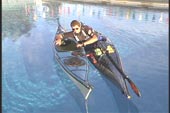
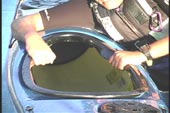
A variation of the first method I frequently employ is using my paddle as a paddle bridge. The paddle spans across both kayaks under both of my armpits. I am still resting over my partner's front deck but I have the added rigidity of my paddle shaft to help with stabilizing. As a side note, some of the smaller students in my class have had more difficulty with the paddle bridge because of their size. At 6'7" it is easy for me.
I like using the paddle bridge because I am keeping in contact with my paddle and it keeps the paddle out of the way. I can also put my partner's paddle under my arms and have two paddles in the bridge.
As you can see this method allows your partner to re-enter their cockpit while you are completely out of their way. You are watching them and can react to their body movements more easily because you can see them. You are also in a position to provide different types of assistance.
Once your partner is in their cockpit and begins to attach their spray skirt to the coaming you need to have your hands out of the way. I recommend you continue to rest on their front deck and partially hug their kayak. Be sure to keep your inside forearm, hand and fingers from between the kayaks. They are easy to break in rough conditions with the kayaks smashing together. Grabbing deck lines is another alternative to the partial hug.
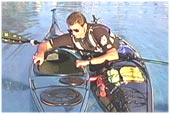
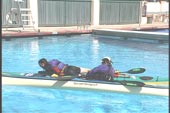
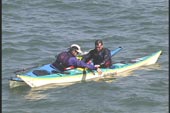
There are times when you will not have the luxury of getting into the bow to stern orientation. If you have the time (meaning immersion time is not a factor) then walk the kayak (see USK article "Walking A Kayak") so you are in the bow to stern position.
If you have to stabilize in the bow to bow orientation there are a few options from which to choose. You can try using a straight locking arm across the cockpit and use your other hand on the near side of the coaming. While this can work in calm water I found I had to use a great deal of strength in rough water. I also found I was in the way when my partner was getting in and out of the cockpit.
When I tried resting in the cockpit for more stability, I found I was obstructing my partner even more than using the straight arm. However, resting in the cockpit provided more stability with less effort than the strait arm method. If you are modest the bow to bow methods are good for nature calls because your partner is not looking at you.
The bow to bow orientation does not allow you to watch what your partner is doing and makes it very difficult to provide any extra assistance.
Another bow to bow method is one I call the arm/paddle wrap. I have yet to find a universal name for this method. You create a paddle bridge behind both coamings and you wrap your inside arm behind and under the paddle shaft and then grab the inside coaming. Your other hand grabs the inside coaming more towards the front. I have to say I dislike this method but I have seen others who like to use it but they were never in very rough conditions.
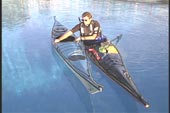
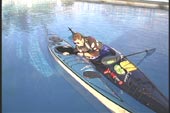
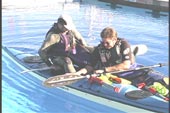

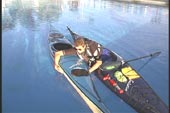
Hugging the kayak does provide stability but I recommend you avoid putting your arms, hands and fingers between the kayaks in any conditions where the kayaks are banging together. As I said earlier, using deck lines is a good alternative. Another reason why deck lines are so important.
As you can see, when you are hugging the front deck in the bow to bow orientation you are not in any position to see or help your partner. Hugging methods should only be used when no other option is available and remember to keep your arm from going between the kayaks.
When you hug the back deck in the same orientation you are completely obstructing your partner if they are anywhere near the back deck. I discourage using either one of these hugging methods.
If you find yourself in the water and you need to stabilize your partner's kayak use this variation. Start on the opposite side of your partner. Reach across the front of their coaming with one hand and grip the inside coaming with the other. Counter balance their forces so you keep the kayak upright.
If you have additional help you can also do a double cockpit hold in the bow to stern orientation. Here we are performing it with a triple paddle bridge. The swimmer is re-entering their kayak with the feet first method between the kayaks. This variation also allows one of the two stabilizers to lend a hand to the person in the water while still helping to stabilize the kayak.
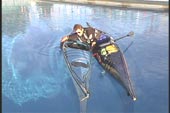
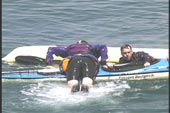
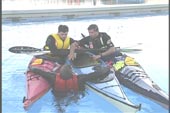
As I stated at the beginning of this article, stabilizing your partner's kayak is a fundamental skill you need to master if you want to be an asset to your partner and the group. Keeping a kayak stable in rough conditions takes work and skills that are well orchestrated. I recommend you practice these techniques with your partner(s). It is best to start in calm water to learn the movements and hand placements. Then use the different methods while your partner stands in their kayak. Standing requires good stability. Then go out to a place that has reflective waves to get the full effect of bouncing around when trying to perform the skills.
I appreciate a partner who is there for me when I need assistance. This is a perfect example of "Do unto others..."
Written by Wayne Horodowich
Pictures seen above were taken from the USK Video "Capsize Recoveries & Rescue Procedures"
© Copyright USK